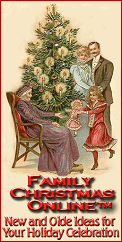 | |
|
|
ELECTRIC
|
|
A- This circa 1906 set from Empire is quite rare in that it is a 14 light set that is parallel wired rather than series wired. Each of the lamps in this outfit are rated for 120 volts, and burn at an extremely high temperature. Sets of this type were often as dangerous as the candles they were replacing due to these high temperatures. B- A close up of the label on the end of the box. C- A look inside the box shows the 120 volt lamps and the festoon. Note the junction box as well, allowing additional festoons to be added to easily expand the light set.
A- A very hard to find outfit offered for sale in 1906 by T.H. Bullock and Company, predominately a department store window fixture company. The company advertised two different outfits as being available: Outfit No. 1 with 24 colored lamps and a 50ft. cord for $11.00, and the outfit pictured here which is No. 2, with a 35 ft. cord and 16 colored lamps with a selling price of $9.50. (The set actually includes 2 spare lamps, for a total of 18, which was common practice at the time). B- A look inside the box reveals that the string was manufactured by General Electric, as evidenced by the round, barrel type junction box and typical green ceramic sockets sold by GE at the time. It is probable that T.H. Bullock and Company purchased boxed outfits from GE, and had them house-branded with their name. General Electric did not sell lighting outfits directly to the public, but through distributors, which were mainly local electric distributing concerns and independent hardware stores. C- With the festoon removed from the box, the lamps can now be seen. The set retains 10 of the original lamps, which are the ones with flaking paint. The remainder are Japanese imported lamps, of true colored glass.
A- An eight light set of Santa Claus Electric Candles by the Jaeger Company, circa 1906. The size of this box is unusual in that it is considerably smaller than wooden outfit boxes, most likely due to the fact that the set features only the one festoon of lights. Label reads "Copyright 1906 by Mugler Engraving Company." B- A close up view of the end label on the box, featuring three children in period clothing. C- Inside the box, one can see the small lamp compartment, the green ceramic sockets and the white screw plug for attaching to the light fixture. No junction box is evident on this outfit, indicating that was one of the less expensive kits not designed to be expanded.
In 1910, General Electric, by far America's
largest miniature lamp manufacturer, changed the design of their miniature
Christmas bulbs, making them perfectly round in shape. The lamps still
utilized carbon filaments. By 1916, GE introduced
tungsten filaments in
their Christmas lamps, selling them under the Mazda trademarked name. 
Tungsten is a superior filament material, burning cooler, longer, using far less current and providing a consistent light output from lamp to lamp. The earliest of these round tungsten filament lamps still had the exhaust tip, but by 1916, the tip had been moved to the bottom of the glass envelope, and was now contained within the screw base part of the unit. In 1920, GE again changed their lamp style, this time making it a cone or flame shape. This basic form was to remain in use until the late 1970s. The 1920 magazine ad to the right is courtesy of Maria Cudequest, author of the Everything Croton blog and lover of all things Christmas.
|


|
||||||||||||||||||||||
|
Note: OldChristmasTreeLights? and FamilyChristmasOnline? are trademarks of Breakthrough Communications? (www.btcomm.com).
|

 | ||||||
| Visit our affiliated sites: | ||||||
| - Christmas Memories and Collectibles - | ||||||
 |

|

|
 |

|
 |
|
| - Family Activities and Crafts - | ||||||
 |

|

|

|

|

|
|
| - Music - | ||||||

|

|
 |

|

|

|
|
| - Trains and Hobbies - | ||||||
 |
 |
 |
 |
 |  |
|

|

|

|  |

|

|
|
